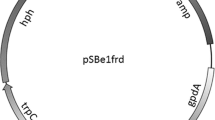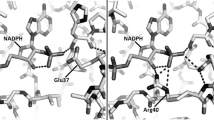Abstract
Deviation from optimal levels and ratios of redox cofactors NAD(H) and NADP(H) is common when microbes are metabolically engineered. The resulting redox imbalance often reduces the rate of substrate utilization as well as biomass and product formation. An example is the metabolism of d-xylose by recombinant Saccharomyces cerevisiae strains expressing xylose reductase and xylitol dehydrogenase encoding genes from Scheffersomyces stipitis. This pathway requires both NADPH and NAD+. The effect of overexpressing the glycosomal NADH-dependent fumarate reductase (FRD) of Trypanosoma brucei in d-xylose-utilizing S. cerevisiae alone and together with an endogenous, cytosol directed NADH-kinase (POS5Δ17) was studied as one possible solution to overcome this imbalance. Expression of FRD and FRD + POS5Δ17 resulted in 60 and 23 % increase in ethanol yield, respectively, on d-xylose under anaerobic conditions. At the same time, xylitol yield decreased in the FRD strain suggesting an improvement in redox balance. We show that fumarate reductase of T. brucei can provide an important source of NAD+ in yeast under anaerobic conditions, and can be useful for metabolic engineering strategies where the redox cofactors need to be balanced. The effects of FRD and NADH-kinase on aerobic and anaerobic d-xylose and d-glucose metabolism are discussed.



Similar content being viewed by others
References
Anderlund M, Nissen TL, Nielsen J, Villadsen J, Rydstrom J, Hahn-Hägerdal B, Kielland-Brandt MC (1999) Expression of the Escherichia coli pntA and pntB genes, encoding nicotinamide nucleotide transhydrogenase, in Saccharomyces cerevisiae and its effect on product formation during anaerobic glucose fermentation. Appl Environ Microbiol 65:2333–2340
Arikawa Y, Enomoto K, Muratsubaki H, Okazaki M (1998) Soluble fumarate reductase isoenzymes from Saccharomyces cerevisiae are required for anaerobic growth. FEMS Microbiol Lett 165:111–116
Bergdahl B, Heer D, Sauer U, Hahn-Hägerdal B, van Niel EW (2012) Dynamic metabolomics differentiates between carbon and energy starvation in recombinant Saccharomyces cerevisiae fermenting xylose. Biotechnol Biofuels 5:34
Besteiro S, Biran M, Biteau N, Coustou V, Baltz T, Canioni P, Bringaud F (2002) Succinate secreted by Trypanosoma brucei is produced by a novel and unique glycosomal enzyme, NADH-dependent fumarate reductase. J Biol Chem 277:38001–38012
Bieganowski P, Seidle HF, Wojcik M, Brenner C (2006) Synthetic lethal and biochemical analyses of NAD and NADH kinases in Saccharomyces cerevisiae establish separation of cellular functions. J Biol Chem 281:22439–22445
Brat D, Boles E, Wiedemann B (2009) Functional expression of a bacterial xylose isomerase in Saccharomyces cerevisiae. Appl Environ Microbiol 75:2304–2311
Bro C, Regenberg B, Forster J, Nielsen J (2006) In silico aided metabolic engineering of Saccharomyces cerevisiae for improved bioethanol production. Metab Eng 8:102–111
Bruinenberg PM, de Bot PHM, van Dijken JP, Scheffers WA (1983) The role of redox balances in the anaerobic fermentation of xylose by yeasts. Eur J Appl Microb Biotechnol 18:287–292
Eliasson A, Christensson C, Wahlbom CF, Hahn-Hägerdal B (2000) Anaerobic xylose fermentation by recombinant Saccharomyces cerevisiae carrying XYL, XYL2, and XKS1 in mineral medium chemostat cultures. Appl Environ Microbiol 66:3381–3386
Gietz RD, Sugino A (1988) New yeast-Escherichia coli shuttle vectors constructed with in vitro mutagenized yeast genes lacking six-base pair restriction sites. Gene 74:527–534
Gordon EH, Pealing SL, Chapman SK, Ward FB, Reid GA (1998) Physiological function and regulation of flavocytochrome c3, the soluble fumarate reductase from Shewanella putrefaciens NCIMB 400. Microbiology 144(Pt 4):937–945
Guldener U, Heck S, Fielder T, Beinhauer J, Hegemann JH (1996) A new efficient gene disruption cassette for repeated use in budding yeast. Nucleic Acids Res 24:2519–2524
Harhangi HR, Akhmanova AS, Emmens R, van der Drift C, de Laat WT, van Dijken JP, Jetten MS, Pronk JT, Op den Camp HJ (2003) Xylose metabolism in the anaerobic fungus Piromyces sp. strain E2 follows the bacterial pathway. Arch Microbiol 180:134–141
Ho NW, Chen Z, Brainard AP (1998) Genetically engineered Saccharomyces yeast capable of effective cofermentation of glucose and xylose. Appl Environ Microbiol 64:1852–1859
Hou J, Vemuri GN, Bao X, Olsson L (2009) Impact of overexpressing NADH kinase on glucose and xylose metabolism in recombinant xylose-utilizing Saccharomyces cerevisiae. Appl Microbiol Biotechnol 82:909–919
Jeffries TW (2006) Engineering yeasts for xylose metabolism. Curr Opin Biotechnol 17:320–326
Jeppsson M, Johansson B, Hahn-Hägerdal B, Gorwa-Grauslund MF (2002) Reduced oxidative pentose phosphate pathway flux in recombinant xylose-utilizing Saccharomyces cerevisiae strains improves the ethanol yield from xylose. Appl Environ Microbiol 68:1604–1609
Jeppsson M, Bengtsson O, Franke K, Lee H, Hahn-Hägerdal B, Gorwa-Grauslund MF (2006) The expression of a Pichia stipitis xylose reductase mutant with higher K(M) for NADPH increases ethanol production from xylose in recombinant Saccharomyces cerevisiae. Biotechnol Bioeng 93:665–673
Karhumaa K, Sanchez RG, Hahn-Hägerdal B, Gorwa-Grauslund MF (2007) Comparison of the xylose reductase-xylitol dehydrogenase and the xylose isomerase pathways for xylose fermentation by recombinant Saccharomyces cerevisiae. Microb Cell Fact 6:5
Kim SR, Park YC, Jin YS, Seo JH (2013) Strain engineering of Saccharomyces cerevisiae for enhanced xylose metabolism. Biotechnol Adv. doi:10.1016/j.biotechadv.2013.03.004
Kötter P, Amore R, Hollenberg CP, Ciriacy M (1990) Isolation and characterization of the Pichia stipitis xylitol dehydrogenase gene, XYL2, and construction of a xylose-utilizing Saccharomyces cerevisiae transformant. Curr Genet 18:493–500
Kötter P, Ciriacy M (1993) Xylose fermentation by Saccharomyces cerevisiae. Appl Microbiol Biotechnol 38:776–783
Krahulec S, Klimacek M, Nidetzky B (2012) Analysis and prediction of the physiological effects of altered coenzyme specificity in xylose reductase and xylitol dehydrogenase during xylose fermentation by Saccharomyces cerevisiae. J Biotechnol 158:192–202
Kuyper M, Harhangi HR, Stave AK, Winkler AA, Jetten MS, de Laat WT, den Ridder JJ, Op den Camp HJ, van Dijken JP, Pronk JT (2003) High-level functional expression of a fungal xylose isomerase: the key to efficient ethanolic fermentation of xylose by Saccharomyces cerevisiae? FEMS Yeast Res 4:69–78
Madhavan A, Tamalampudi S, Ushida K, Kanai D, Katahira S, Srivastava A, Fukuda H, Bisaria VS, Kondo A (2009) Xylose isomerase from polycentric fungus Orpinomyces: gene sequencing, cloning, and expression in Saccharomyces cerevisiae for bioconversion of xylose to ethanol. Appl Microbiol Biotechnol 82:1067–1078
Madhavan A, Srivastava A, Kondo A, Bisaria VS (2012) Bioconversion of lignocellulose-derived sugars to ethanol by engineered Saccharomyces cerevisiae. Crit Rev Biotechnol 32:22–48
Matsushika A, Inoue H, Kodaki T, Sawayama S (2009) Ethanol production from xylose in engineered Saccharomyces cerevisiae strains: current state and perspectives. Appl Microbiol Biotechnol 84:37–53
Meinander NQ, Hahn-Hägerdal B (1997) Influence of cosubstrate concentration on xylose conversion by recombinant, XYL1-expressing Saccharomyces cerevisiae: a comparison of different sugars and ethanol as cosubstrates. Appl Environ Microbiol 63:1959–1964
Minard KI, Jennings GT, Loftus TM, Xuan D, McAlister-Henn L (1998) Sources of NADPH and expression of mammalian NADP+-specific isocitrate dehydrogenases in Saccharomyces cerevisiae. J Biol Chem 273:31486–31493
Mracek J, Snyder SJ, Chavez UB, Turrens JF (1991) A soluble fumarate reductase in Trypanosoma brucei procyclic trypomastigotes. J Protozool 38:554–558
Outten CE, Culotta VC (2003) A novel NADH kinase is the mitochondrial source of NADPH in Saccharomyces cerevisiae. EMBO J 22:2015–2024
Pain J, Balamurali MM, Dancis A, Pain D (2010) Mitochondrial NADH kinase, Pos5p, is required for efficient iron-sulfur cluster biogenesis in Saccharomyces cerevisiae. J Biol Chem 285:39409–39424
Panagiotou G, Grotkjaer T, Hofmann G, Bapat PM, Olsson L (2009) Overexpression of a novel endogenous NADH kinase in Aspergillus nidulans enhances growth. Metab Eng 11:31–39
Parachin NS, Gorwa-Grauslund MF (2011) Isolation of xylose isomerases by sequence- and function-based screening from a soil metagenomic library. Biotechnol Biofuels 4:9
Petschacher B, Nidetzky B (2008) Altering the coenzyme preference of xylose reductase to favor utilization of NADH enhances ethanol yield from xylose in a metabolically engineered strain of Saccharomyces cerevisiae. Microb Cell Fact 7:9
Pitkänen J-P, Vuolanto A (2004) Reactor device. Patent FI118192
Pitkänen J-P, Aristidou A, Salusjärvi L, Ruohonen L, Penttilä M (2003) Metabolic flux analysis of xylose metabolism in recombinant Saccharomyces cerevisiae using continuous culture. Metab Eng 5:16–31
Postma E, Verduyn C, Scheffers WA, Van Dijken JP (1989) Enzymatic analysis of the Crabtree effect in glucose-limited chemostat cultures of Saccharomyces cerevisiae. Appl Environ Microbiol 55:468–477
Pronk JT, Yde Steensma H, Van Dijken JP (1996) Pyruvate metabolism in Saccharomyces cerevisiae. Yeast 12:1607–1633
Roca C, Nielsen J, Olsson L (2003) Metabolic engineering of ammonium assimilation in xylose-fermenting Saccharomyces cerevisiae improves ethanol production. Appl Environ Microbiol 69:4732–4736
Runquist D, Hahn-Hägerdal B, Bettiga M (2010) Increased ethanol productivity in xylose-utilizing Saccharomyces cerevisiae via a randomly mutagenized xylose reductase. Appl Environ Microbiol 76:7796–7802
Ruohonen L, Aristidou A, Frey AD, Penttilä M, Kallio PT (2006) Expression of Vitreoscilla hemoglobin improves the metabolism of xylose in recombinant yeast Saccharomyces cerevisiae under low oxygen conditions. Enzyme Microb Technol 39:6–14
Salusjärvi L, Poutanen M, Pitkänen J-, Koivistoinen H, Aristidou A, Kalkkinen N, Ruohonen L, Penttilä M (2003) Proteome analysis of recombinant xylose-fermenting Saccharomyces cerevisiae. Yeast 20:295–314
Shi F, Kawai S, Mori S, Kono E, Murata K (2005) Identification of ATP-NADH kinase isozymes and their contribution to supply of NADP(H) in Saccharomyces cerevisiae. FEBS J 272:3337–3349
Shi F, Li Z, Sun M, Li Y (2011) Role of mitochondrial NADH kinase and NADPH supply in the respiratory chain activity of Saccharomyces cerevisiae. Acta Biochim Biophys Sin (Shanghai) 43:989–995
Strand MK, Stuart GR, Longley MJ, Graziewicz MA, Dominick OC, Copeland WC (2003) POS5 gene of Saccharomyces cerevisiae encodes a mitochondrial NADH kinase required for stability of mitochondrial DNA. Eukaryot Cell 2:809–820
Toivari MH, Aristidou A, Ruohonen L, Penttilä M (2001) Conversion of xylose to ethanol by recombinant Saccharomyces cerevisiae: importance of xylulokinase (XKS1) and oxygen availability. Metab Eng 3:236–249
van Dijken JP, Scheffers WA (1986) Redox balances in the metabolism of sugars by yeast. FEMS Microbiol Rev 32:199–224
Van Hellemond JJ, Tielens AG (1994) Expression and functional properties of fumarate reductase. Biochem J 304(Pt 2):321–331
Verduyn C, Zomerdijk TPL, van Dijken JP, Scheffers WA (1984) Continuous measurement of ethanol production by aerobic yeast suspensions with an enzyme electrode. Appl Microbiol Biotechnol 19:181–185
Verho R, Londesborough J, Penttilä M, Richard P (2003) Engineering redox cofactor regeneration for improved pentose fermentation in Saccharomyces cerevisiae. Appl Environ Microbiol 69:5892–5897
Wach A, Brachat A, Pohlmann R, Philippsen P (1994) New heterologous modules for classical or PCR-based gene disruptions in Saccharomyces cerevisiae. Yeast 10:1793–1808
Watanabe S, Pack SP, Saleh AA, Annaluru N, Kodaki T, Makino K (2007) The positive effect of the decreased NADPH-preferring activity of xylose reductase from Pichia stipitis on ethanol production using xylose-fermenting recombinant Saccharomyces cerevisiae. Biosci Biotechnol Biochem 71:1365–1369
Watanabe S, Saleh AA, Pack SP, Annaluru N, Kodaki T, Makino K (2007) Ethanol production from xylose by recombinant Saccharomyces cerevisiae-expressing protein engineered NADP(+)-dependent xylitol dehydrogenase. J Biotechnol 130:316–319
Zaldivar J, Nielsen J, Olsson L (2001) Fuel ethanol production from lignocellulose: a challenge for metabolic engineering and process integration. Appl Microbiol Biotechnol 56:17–34
Zhang GC, Liu JJ, Ding WT (2011) Overexpression of water-forming NADH oxidase decreases xylitol formation during xylose fermentation of Saccharomyces cerevisiae. Appl Environ Microbiol 78:1081–1086
Acknowledgments
This study was financially supported by the Academy of Finland being part of the KETJU Research Programme (2006–2010). Technical assistance of Pirjo Tähtinen is gratefully acknowledged.
Author information
Authors and Affiliations
Corresponding author
Electronic supplementary material
Below is the link to the electronic supplementary material.
Rights and permissions
About this article
Cite this article
Salusjärvi, L., Kaunisto, S., Holmström, S. et al. Overexpression of NADH-dependent fumarate reductase improves d-xylose fermentation in recombinant Saccharomyces cerevisiae . J Ind Microbiol Biotechnol 40, 1383–1392 (2013). https://doi.org/10.1007/s10295-013-1344-9
Received:
Accepted:
Published:
Issue Date:
DOI: https://doi.org/10.1007/s10295-013-1344-9




